Terry L. Ettinger Horticulture Consulting Services
Meeting The Needs Of Today With A Vision For The Future
Question of the Week
How to Prune Evergreen Shrubs
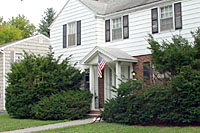 Q. We moved into our first
home this past spring and absolutely love it - except for the huge
evergreen shrubs that are almost completely blocking the front door!
When is the best time to prune evergreen bushes, and how far back
can I cut them?
Q. We moved into our first
home this past spring and absolutely love it - except for the huge
evergreen shrubs that are almost completely blocking the front door!
When is the best time to prune evergreen bushes, and how far back
can I cut them?
A. The first step in pruning evergreens is to identify them, because they're not all created equal when it comes to pruning. To help you identify the evergreens in your landscape, click here.
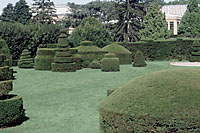 Once you
know which evergreens you're dealing with, I generally recommend pruning
them between mid-June and mid-July.
By then, their new growth has pretty much finished elongating, which allows you to get a sense of just how much of it needs to
be removed to get the effect that you're looking for. Also, the follow year's buds will have not yet set.
Once you
know which evergreens you're dealing with, I generally recommend pruning
them between mid-June and mid-July.
By then, their new growth has pretty much finished elongating, which allows you to get a sense of just how much of it needs to
be removed to get the effect that you're looking for. Also, the follow year's buds will have not yet set.
This is especially important when pruning pines, as they set buds only at the tips of the current season's growth. If those buds are removed later in the summer or early the following spring, you'll leave a “stub” that will never put on new growth.
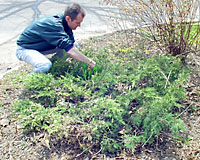 Meanwhile,
you can significantly reduce the size of some overgrown evergreen shrubs without sacrificing their natural form
by selectively removing just a few stems/branches in March or April.
Meanwhile,
you can significantly reduce the size of some overgrown evergreen shrubs without sacrificing their natural form
by selectively removing just a few stems/branches in March or April.
In the picture
above, for example, I'm removing a single large branch from the center of an
overgrown juniper with handpruners
in late April several years ago. Less than five minutes later, I had reduced the
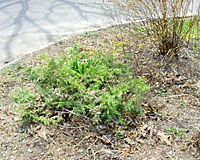 diameter of the plant by the better part of two feet by selectively removing
five branches, at left.
diameter of the plant by the better part of two feet by selectively removing
five branches, at left.
Looking at the plant, it's difficult to tell that it had been pruned as I made the cuts where they would be hidden by the remaining branches. The cuts became even less obvious after the new growth had finished expanding in June.
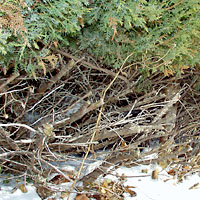 This
is in contrast to the appearance of many overgrown evergreen shrubs
after they're hacked back to bare wood with hedge shears. The
juniper at right, for example, was cut back hard with hedge shears
because it was growing over the adjacent sidewalk. Unfortunately,
the stubs that this process exposed will never produce new shoots.
This
is in contrast to the appearance of many overgrown evergreen shrubs
after they're hacked back to bare wood with hedge shears. The
juniper at right, for example, was cut back hard with hedge shears
because it was growing over the adjacent sidewalk. Unfortunately,
the stubs that this process exposed will never produce new shoots.
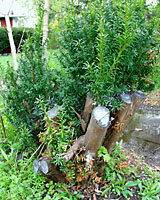 Only
yews
(also know by their genus name, Taxus) are tolerant of really drastic pruning measures.
By drastic, I mean that it's possible to cut back yews to
nothing more than short stubs protruding off of the main trunk.
While there are only extremely rare instances where I might
recommend this, yews are tolerant of this practice
because they can send out new shoots from dormant buds all along
their stems and trunk, at left.
Only
yews
(also know by their genus name, Taxus) are tolerant of really drastic pruning measures.
By drastic, I mean that it's possible to cut back yews to
nothing more than short stubs protruding off of the main trunk.
While there are only extremely rare instances where I might
recommend this, yews are tolerant of this practice
because they can send out new shoots from dormant buds all along
their stems and trunk, at left.